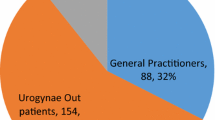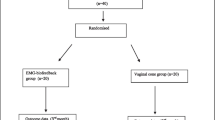Abstract
The aim of the study was to evaluate the effectiveness of in-office physiotherapy for stress, mixed and urge incontinence. All subjects underwent urodynamics. Those with stress incontinence received pressure biofeedback pelvic floor exercises and electrical stimulation. Those with detrusor instability and mixed incontinence received bladder drills, anticholinergic medications, electrical stimulation and pressure biofeedback pelvic floor exercises. All those with atrophic vaginitis received vaginal estrogen. Weekly treatment sessions for 4 weeks and then monthly for 2 months were directed by a trained gynecologic nurse. Weekly bladder diaries were kept. Outcome measures included diary-recorded incontinence episodes and subjective reporting of continence. One hundred and four women completed the program. Weekly incontinence episodes decreased from 22 to 2 (<0.05) in both stress and detrusor instability/mixed incontinence groups. An average of 4.5 sessions over 6.1 weeks was necessary for optimal response; 86% reported subjective improvement. It was concluded that multimodality treatment of incontinence leads to a 90% reduction in incontinence episodes. The relative contribution of each treatment modality requires further study.
Similar content being viewed by others
References
Clinical Practice Guideline: Urinary Incontinence in Adults (AHCPR Publication No. 92-0038) rockville, MD: Agency for health Care Policy and Research, 1992.
Kegel A. Progressive resistance exercise in the functional restoration of the perineal muscles.Am J Obstet Gynecol 1948; 56:238–248
Burgio KL, Robinson JC, Engel BT. The role of biofeedback in Kegel exercise training for stress urinary incontinence.Am J Obstet Gynecol 1986; 154:58–64
Fall M, Lindstrom S. Electrical stimulation: a physiologic approach to the treatment of urinary incontinence.Urol Clin North Am 1991; 18:393–407
Peattie AB, Plevnik S, Stanton S. Vaginal cones: a conservative method of treating genuine stress incontinence.Br J Obstet Gynaecol: 1988; 95:1049–1053
Fantl JA, Wyman JF, McClish KD et al. Efficacy of bladder training in older women with urinary incontinence.JAMA 1991; 265:609–613
Hilton P, Stanton SL. The use of intravaginal oestrogen cream in genuine stress incontinence.Br J Obstet Gynaecol 1983;90:940–944
Tapp AJS, Cardozo LD, Versi E, Cooper D. The treatment of detrusor instability in post-menopausal women with oxybutynin chloride: a double blind placebo controlled study.Br J Obstet Gynaecol 1900;97:521–526
Abrams P, Blaivas JG, Stanton SL, Andersen JT. The standardization of terminology of lower urinary tract function recommended by the International Continence Society.Int Urogynecol J 1990;1:45–58
Fall M, Lindstrom S. Functional electrical stimulation: physiologic basis and clinical principles.Int Urogynecol J 1994;5:296–304
Tomkins J, Martel R, Davila D. Diltiazem use for bladder instability.Int Urogynecol J 1991;3:276 (abstract)
Sand P. Pelvic floor stimulation treatment of the low pressure urethra.Int Urogynecol J 1993;4:325 (abstract)
Andersen JT, Blaivas JG, Cardozo L, Thuroff J. Lower urinary tract rehabilitation techniques: seventh report on the standardization of terminology of lower urinary tract function.Int Urogynecol J 1992;3:75–80
Bump RC, Hurt WG, Fantl JA, Wyman JF. Assessment of Kegel pelvic muscle exercise performance after brief verbal instruction.Am J Obstet Gynecol 1991;165:322–392
Wall LL, Davidson TG. The role of muscular re-education by physical therapy in the treatment of genuine urinary stress incontinence.Obstet Gynecol Surv 1992;47:322–321
Olah KS, Bridges N, Denning J, Farrar DJ. The conservative management of patients with symptoms of stress incontinence: a randomized, prospective study comparing weighted vaginal cones and interferential therapy.Am J Obstet Gynecol 1990;162:87–92
Bent AE, Sand PK, Ostergard DR, Brubaker LT. Transvaginal electrical stimulation in the treatment of genuine stress incontinence and detrusor instability.Int Urogynecol J 1993;4:9–13
Sand PK, Richardson DA, Staskin DR et al. Pelvic floor stimulation in the treatment of genuine stress incontinence. Presented at the NIDDK Symposium on Women's Urological Health Research. Bethesda, MD, March 1994
Fall M. Does electrostimulation cure urinary incontinence?J Urol 1984;131:664–667
Plevnik S, Janez J, Vodusek DB. Electrical stimulation in clinical neurourology. In: Krane RJ, Sirosky MD (eds) Little, Brown and Company, 1982:559–571
Author information
Authors and Affiliations
Additional information
Editorial Comment: The authors report their experience using a multimodality approach to the conservative management of urinary incontinence. They clearly outline their protocols in patients with stress, urge and mixed incontinence. They chose a subjective parameter of outcome with seemingly good compliance, probably as a result of their stressing the educational component of their approach. Such re-enforcement allows them to report relatively good results using their protocols. The exact role of each modality and its contribution to the management of these patients will have to await well controlled prospective and randomized studies.
Rights and permissions
About this article
Cite this article
Davila, G.W., Bernier, F. Multimodality pelvic physiotherapy treatment of urinary incontinence in adult women. Int Urogynecol J 6, 187–194 (1995). https://doi.org/10.1007/BF01894260
Issue Date:
DOI: https://doi.org/10.1007/BF01894260




